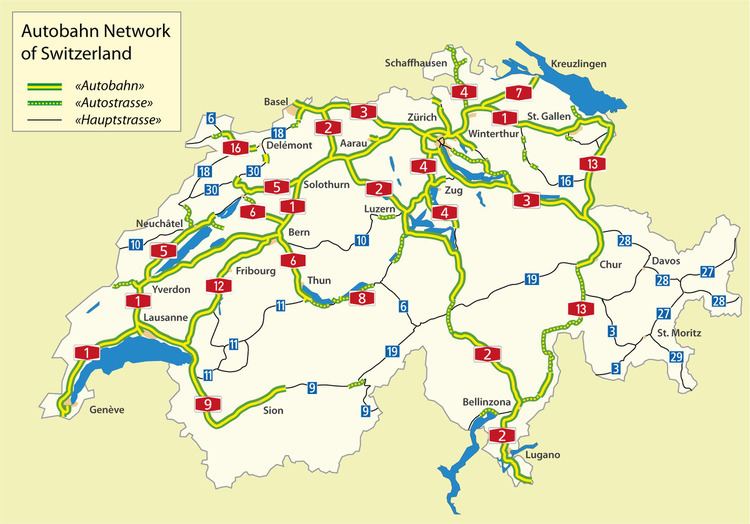 | ||
Autobahnen in German, Autoroutes in French, Autostrade in Italian, Autostradas in Romansch are the names of the national freeways or motorways of Switzerland. Two of the most important freeways are the A1, running from St. Margrethen in northeastern Switzerland's canton of St. Gallen through to Geneva in southwestern Switzerland, and the A2, running from Basel in northwestern Switzerland to Chiasso in southern Switzerland's canton of Ticino, on the border with Italy.
Contents
- History
- Current density
- Toll requirements
- List of AutobahnenAutoroutesAutostrade
- Military significance
- References
Swiss motorways have a general speed limit of 120 km/h (75 mph). Motorways are restricted to vehicles that can obtain a speed of at least 80 km/h (50 mph).
History
A short stretch of autobahn around the Lucerne area in 1955 created Switzerland's first autobahn. For Expo 1964, an autoroute was built between Lausanne and Geneva. The Bern-Lenzburg autobahn was inaugurated in 1967.
Current density
The Swiss autobahn/autoroute network has a total length (as of April 2012) of 1,763.6 kilometres (1,095.9 mi), of the planned 1,893.5 kilometres (1,176.6 mi), and has, by an area of 41,290 km², also one of the highest motorway densities in the world with many tunnels. There are 200 tunnels with a total length of 220 kilometres (140 mi).
The Swiss autobahn/autoroute network has not yet been completed; priority has been given to the most important routes, especially the north-south and the west-east axis.
Swiss autobahns/autoroutes very often have an emergency lane except in tunnels. Some newly built autobahn sections, like the lone section crossing the Jura region in the north-western part of Switzerland, have only emergency bays.
Toll requirements
The Swiss autobahn/autoroute system requires the purchase of a vignette (toll sticker) — which costs 40 Swiss francs — for one calendar year in order to use its roadways, for both passenger cars and trucks. The Swiss vignette is offered only as an annual toll sticker. Trucks also have to pay a toll based on the tonnage and the distance.
The cantons abandoned the right to raise road and bridge tolls to the Confederation, and the only way of funding the road system is partly through the vignette, the motor tax for every registered vehicle and mainly through the federal taxes levied on each liter of gasoline, diesel fuel, etc.
Tolls for the use of particular roads, tunnels or bridges cannot be raised according to the Swiss constitution and so even the use of cost-intensive pieces of infrastructure such as the Gotthard Road Tunnel is financed by the entire system. There are only the exceptions of the Munt la Schera and Great St Bernard tunnels and of the train shuttles carrying road vehicles.
List of Autobahnen/Autoroutes/Autostrade
Note: Portions in italics indicate routes under construction or projection.
Military significance
When planning the motorway network, the demands of the Air Force were taken into consideration by planning the motorways so they could be used as alternate runways (highway strips). Various stretches of motorway were constructed with straight sections of about 2 km length. The guardrails were replaced by steel cables and could be removed if necessary within a few hours. After cleaning the roadways, painting the runway markings, and setting up wireless connections, such a motorway section could be used as a runway.
The last example of a "runway" was Highway A1 - section Murten - be Payerne, opened in the 1990s, parallel to the runway of the airbase in Payerne.
The use of aircraft was occasionally tested by the WK-units (FLPL Dept.). The section in Oensingen was used on 16 September 1970 from 12-15 o'clock for a military exercise, which was characteristic of the Cold War. The level of secrecy was accordingly high. All unnecessary notices were therefore to be avoided, but many spectators were present, and the media reported it.
The aviators and airport Regiment 3 with the DH-112 Venom performed exercises, which placed great demands on the infrastructure and the skill of the pilots. The exercise was successful, which served as a lesson for other landing and takeoff exercises in other sections of the Swiss motorway network, the last time in 1991 Tessin.
Never tested following motorway sections:
With the end of the Cold War and the restructuring of the Swiss Army objects are continuously released from the inventory of military infrastructure, including various national roads buildings. With the reform of the army in 1995, the concept of highway-airfields was abandoned. No further operations upkeep or testing is undertaken at this time.
Another discontinued double use of motorways is the Sonnenberg Tunnel the A2 near Lucerne. Originally designed as the largest civilian shelter of Switzerland and one of the largest in the world and subject to annual functionality tests until 2005, due to increasing maintenance costs its use as a civil defense shelter has been greatly reduced. Previously it accommodated 17,000 people, today it has a capacity of 2,000.
Finally, the Gotthard road tunnel was also dismissed from the inventory of strategic buildings. After a devastating fire accident in 2001 and the subsequent renovation of the blocked section, explosives stored in a side chamber in the interior of the tunnel were removed during the reconstruction.
